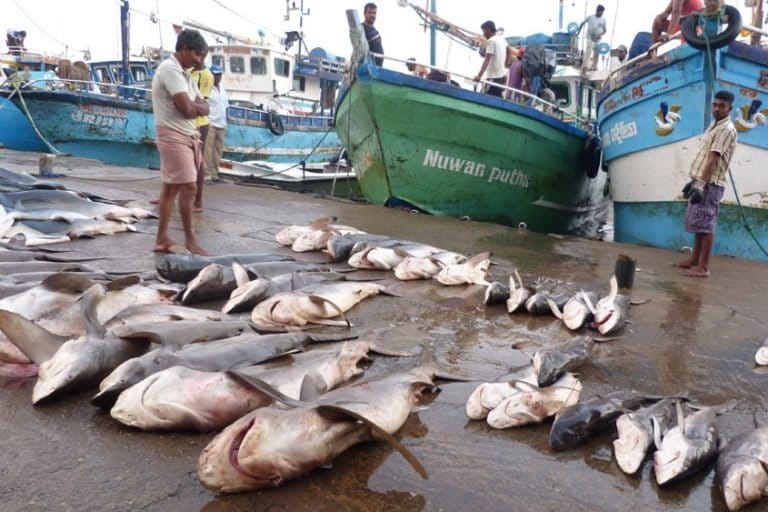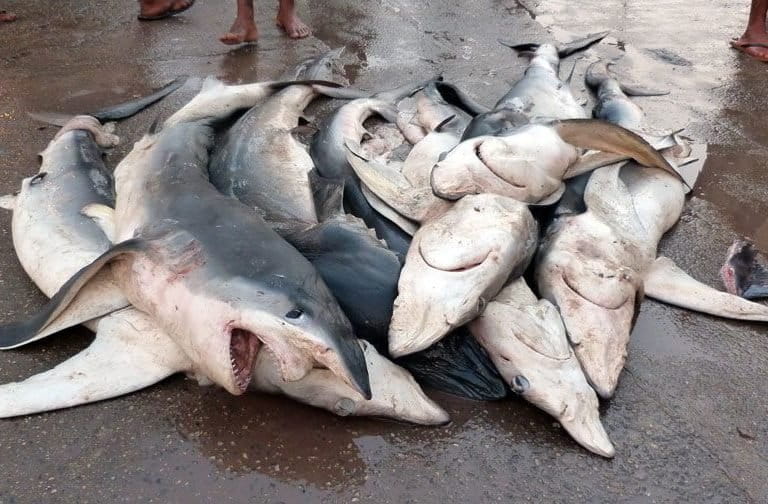- With the killing of sharks and rays on the rise, Sri Lanka played a lead role in pushing three proposals to extend global protection to 18 species at the recently concluded CITES wildlife trade summit in Geneva.
- Sixty-three sharks and 42 ray species are found in Sri Lankan waters, and are threatened by overexploitation driven by an ever-increasing demand for sharks fins, meat, and liver oil.
- While five species of sharks currently enjoy legal protection against the species trade in Sri Lanka, conservationists see an urgent need to extend protection to all reef sharks and other endangered shark and ray species.
Decades ago along the beaches of Sri Lanka, fish sellers used bicycles to transport their catch, including sharks. It was said the sharks were often so big that, when tied down to the bicycle frame, their snouts and tail fins would touch the ground at either end.
“But not anymore,” says Hiran Jayawardene, the founder and former chairman of the National Aquatic Resources Research and Development Agency (NARA). He says this decline is evident at shark landing sites around the country, where fishermen are no longer pulling in the large sharks they did before.
Sri Lanka’s waters are home to 63 shark and 42 ray species, but many are threatened by overexploitation to feed the growing demand for shark fins, meat, and liver oil.

But the country is looking to change that, rolling out a raft of regulations in the past two decades to protect various shark species domestically, and, more recently, spearheading a push for the global protection of highly exploited and endangered mako sharks.
Among the many proposals it supported at last month’s global summit of the Convention on International Trade in Endangered Species (CITES), Sri Lanka called for the inclusion of the two species of mako sharks, shortfin (Isurus oxyrinchus) and longfin (I. paucus), in CITES Appendix II, which would subject their trade to strict rules. It also called for similar protections for six species of giant guitarfishes and 10 species of wedgefishes.
The IUCN Red List includes both species of mako sharks as endangered, all six species of giant guitarfishes as critically endangered, and nine of the 10 species of wedgefishes as critically endangered.
“All these species have seen very steep declines in their populations in recent decades and this is mostly due to overfishing, habitat destruction and degradation,” Rima Jabado, the IUCN Shark Specialist Group’s regional vice-chair for the Indian Ocean, told Mongabay.
Kim Friedman, senior fisheries resources officer at the U.N.’s Food and Agriculture Organization (FAO), said a mere listing would not protect the species. “It matters to change the management framework of fisheries to get implemented at ground level.”

Protecting the ocean’s predators
In Sri Lanka, five species of sharks enjoy legal protection: the pelagic thresher shark (Alopias pelagicus), bigeye thresher (A. superciliosus), common thresher (A. vulpinus), oceanic whitetip shark (Carcharhinus longimanus), and whale shark (Rhincodon typus). Since 2001, local fishing regulations have required that any of these sharks that are caught must be brought to shore with their fins attached. The rule was enforced to curb shark finning, the practice of catching a shark, cutting off its fins mid-ocean, then dumping the live shark back into the water, where, unable to swim, it dies.
In 2013, Sri Lanka went further and introduced a five-year National Plan of Action for the Conservation and Management of Sharks (NPOA), specifying measures for adoption and implementation of new shark conservation and management mechanisms.
Sisira Haputhantri, an ocean fisheries expert at NARA, told Mongabay that the shark action plan, since extended for another five years, should help monitor the implementation of the conservation initiatives.
Over the past 10 years, the country has official exported 59 metric tons of shark fins annually. But there’s evidence that greater volumes of shark fins are being smuggled out of the island.
There are recorded and unrecorded instances of fins being exported as dried fish, said Sevvandi Jayakody, Sri Lanka’s coordinator for the recent CITES summit.
By listing mako sharks in Appendix II, scientists can gather accurate figures of sharks killed as part of the international trade, which would help determine whether catches are reaching what’s known as the maximum sustainable yield (MSY), Jayakody said.
“We do not want to stop shark fishery but we do want sustainable fishery. CITES should help educate regulators and fisherfolk alike, on the new developments,” she said.
Both species of mako are oceanic, roam the high seas, and undertake long-distance migrations, making local protection mechanisms of somewhat limited value, according to Rex I. de Silva, author of Sharks of Sri Lanka. The CITES listing is therefore vital to protect the species in international seas.

John E. Scanlon, former secretary-general of CITES, told Mongabay that the convention had been used effectively since 2013 to regulate the international trade in commercially harvested sharks and rays. These include hammerheads (family Sphyrnidae), porbeagles (Lamna nasus) and oceanic whitetip sharks and manta rays, as well as silky (Carcharhinus falciformis) and thresher sharks together with devil rays (genus Mobula) since 2016. Mako sharks are the latest to join the list.
“Following the 2003 listing of sharks, there had been great progress in the conservation of white sharks, basking sharks and whale sharks,” Jabado said. “The other listings are much more recent, and it is unlikely we will see a difference in the population size of these species just yet.”
Conservation management
What countries need is better fisheries management to curb overexploitation, Jabado said.
“Many species in the Indian Ocean are considered migratory but many are endemic to this region,” she said. “This means, we need higher levels of species protection. To ensure protection of the migratory species, the best strategy is collaboration with other countries in the region, both on research and conservation.”
Daniel Fernando of Blue Resources Trust initiated a nine-day survey of fish markets and landing sites at 11 localities in Sri Lanka that led to the identification of 34 shark species. Five of them are sharks new to science. “If a short survey of nine days could help discover new species, it shows the need for greater research on Sri Lanka’s sharks,” Fernando told Mongabay.
Following the listing of sharks and rays to Appendix II during the 2013 CITES summit in Bangkok, Sri Lanka’s Department of Fisheries Resources and the FAO conducted a joint survey to identify the successes and challenges experienced in the implementation of CITES provisions.
The survey showed poor awareness about the CITES process among stakeholders. However, they had a satisfactory level of knowledge of other measures, with more than 69 percent of respondents having awareness of management measures.

“Shark conservation in Sri Lanka appears to be at the starting point: It has a long way to go in order to reach conservation efforts undertaken by neighbours such as the Maldives,” said Howard Martenstyn, a marine biologist with the Centre of Research for Indian Ocean Marine Mammals (CRIOMM).
Promotion of ecotourism of sharks and manta rays as an alternative to fishing can offer a different revenue model for the local economy, Martenstyn said.
Banner image of a stuffed shark toy at the Sri Lankan delegation’s seat at last month’s CITES summit in Geneva. Sri Lanka played a leading role in pushing for greater protection for sharks and rays at the summit. Image courtesy of IISD Reporting Service.
